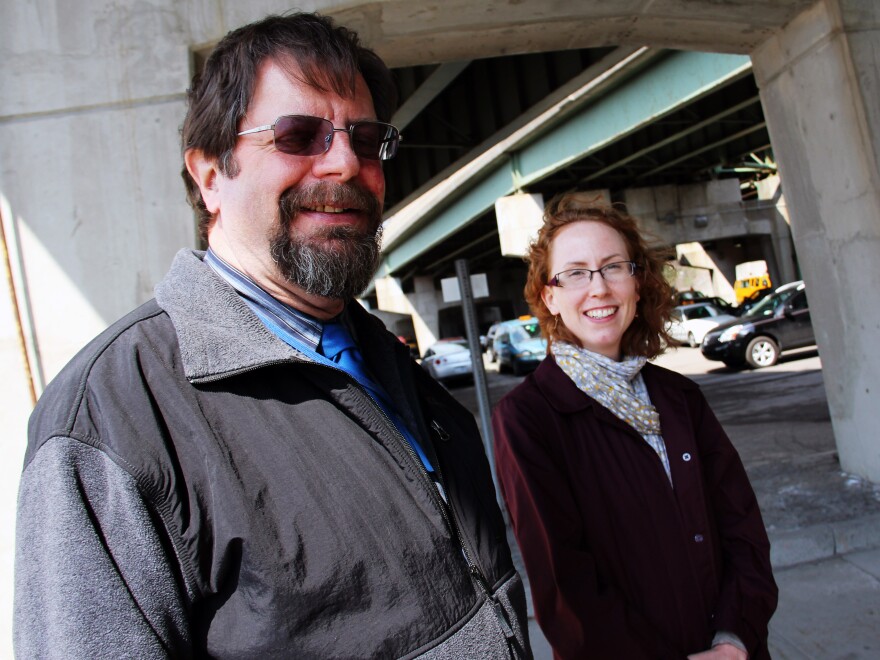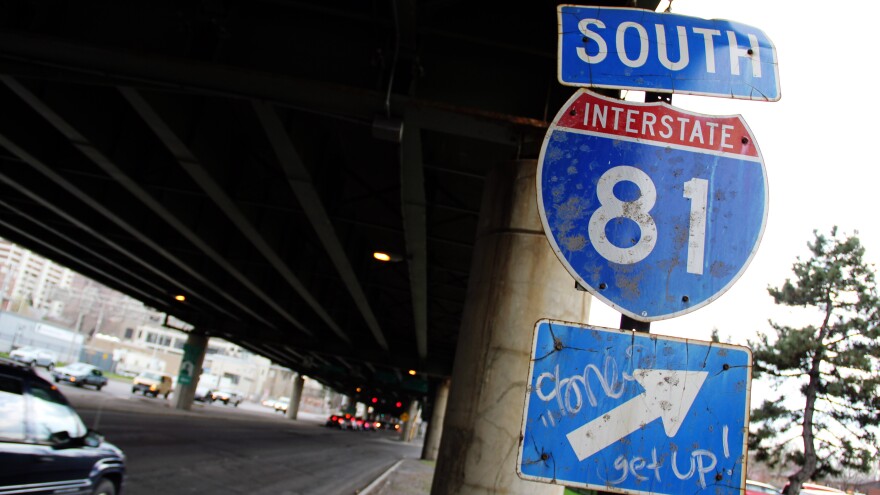Interstate 81 runs through the heart of Syracuse, N.Y., where a 1.4-mile-long elevated stretch of the highway is known locally as "the viaduct." Like many road projects built in the middle of the last century, I-81 is bumping up against the end of its life span. While officials say it's still safe to drive on, the highway is crumbling in parts.
Now, the region is starting to think about what Syracuse might look like without the viaduct, which both speeds traffic through the city and divides the community along economic and racial lines. If the viaduct is torn down, Syracuse would join San Francisco and Milwaukee, where the removal of urban highways over the past two decades has spurred development. Still, it's early in the process.
Syracuse's 'Berlin Wall'
Hazel Miller lives about 100 feet from I-81 in Pioneer Homes, a low-rise public housing project in Syracuse. She moved there 40 years ago, when homes were still being ripped down to make room for the elevated highway.
I-81 in Syracuse was built right through the middle of one of New York state's first public housing projects, gutting this predominantly African-American neighborhood. As long as Miller has lived there, the highway has driven away commerce.
"We don't even have a grocery store close," she says.

Syracuse Common Council President Van Robinson says replacing the viaduct with a street-level boulevard would breathe life into the city's withered urban core. He has long seen the viaduct as a barrier that separates the haves from the have-nots.
"It's not a question of if it should be torn down. The question is when will it be torn down," he says.
Robinson, who founded the local chapter of the NAACP, has wanted to remove I-81 since he first arrived in Syracuse decades ago.
"It was a city divided," he says. "In fact, I immediately, at that time ... called it the 'Berlin Wall.' "
On one side of that wall is prosperous University Hill, home to the institutions that drive Syracuse's local economy. On the other side is poverty and neglect. A few years ago, some streets within the Pioneer Homes were gated off in response to a rash of drive-by shootings. Robinson says tearing down I-81 is a relatively simple step that could help turn the neighborhood around.
"It's not as if it's a hundred miles of roadbed we have to put down. It's 1.4 miles," he says.
Sticker Shock
A few years ago, Emanuel Carter, a professor at the State University of New York's College of Environmental Science and Forestry, teamed up with a local citizens league on a study called " ." The main finding was that removing the I-81 viaduct would spur significant development.
"We're in full-blown sprawl mode right now," Carter says. "And one of the ways we can kind of refocus on the core would be to have [I-81] cease to be an impediment."
Bill Egloff, the project manager for the New York State Department of Transportation who is in charge of keeping I-81 standing, admits that something needs to be done about the highway. It plays a vital role in making Syracuse what planning officials call a "20-minute city," where you can drive anywhere you need to quickly and easily. But Egloff says tearing it down is no simple fix.

"If the remaining traffic had to negotiate the city streets as they are right now, that would be a problem," he says.
The state's transportation department is in the early stages of a planning process called the . Planners recently gauged public opinion on three basic options: keep the viaduct and update it to current standards; tear it down and build a sunken roadway; or tear it down and build a boulevard. Egloff says none of the options will be cheap.
"Five years ago, we had our structures engineer give us a rough estimate of the whole deck replacement and that was in the neighborhood of $350 million," says Egloff.
Planning officials now say that "cheap" option would be at least a half a billion dollars. Traditionally, nearly all of that price tag is picked up by the federal government.
It's a big investment with a big impact on the future of the city.
A Long, Lasting Shadow?
Don Mitchell, a professor of geography at Syracuse University, is concerned that removing I-81 could unleash a flood of gentrification. Still, he says he's generally supportive of tearing down one of the city's most uninviting assets.
"It's a huge psychological as well as physical barrier," Mitchell says.
But for Hazel Miller, I-81 in her backyard is part of what she calls the "beautiful scenery" of flowing traffic. She would rather keep the viaduct as is. Miller is not confident that what might come next will be any better.
"I don't know how wide that [proposed] boulevard is going to be, but I know [there] wouldn't be as many tractor-trailer trucks and stuff like that going over," she says.
Officials say a plan of action for I-81 will not be in place until 2017. In the meantime, the elevated highway will continue to cast its long shadow.
Copyright 2020 WXXI 暗黑爆料. To see more, visit . 9(MDAxNDQ2NDAxMDEyNzU2NzM2ODA3ZGI1ZA001))



